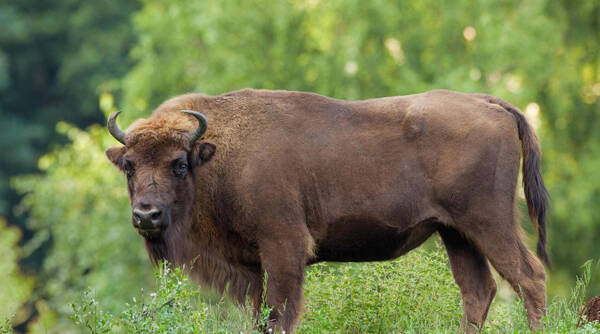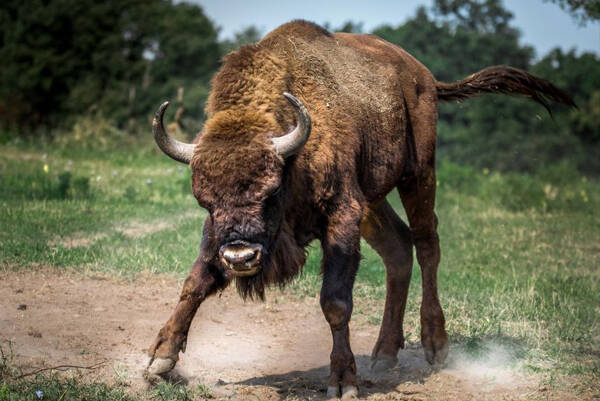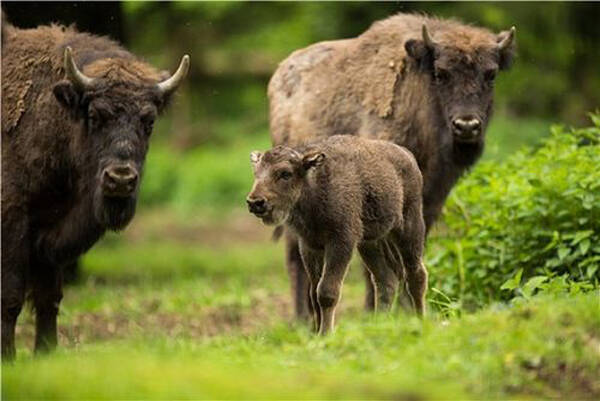Bison bonasus
IUCN
LCBasic Information
Scientific classification
- name:Bison bonasus
- Scientific Name:Bison bonasus
- Outline:Ungulata
- Family:Artiodactyla Bovidae Bison
Vital signs
- length:About 2.9 meters
- Weight:600-1000kg
- lifetime:About 15 years
Feature
The largest native herbivore in Europe, with a very large body
Distribution and Habitat
Reintroduced: Belarus, Lithuania, Poland, Romania, Russian Federation, Slovakia, Ukraine and Kyrgyzstan.
Extinct and uncertain origin: Austria, Belgium, Czech Republic, Denmark, Estonia, France, Hungary, Liechtenstein, Moldova, Netherlands, Serbia, Sweden and Switzerland.
The European bison inhabits open spaces in deciduous broad-leaved forests, scrubland. Altitudes range from 0-2100 m. Most European bison subpopulations were (re)introduced into forest habitats. However, habitat use patterns vary widely between populations and are largely influenced by habitat structure (forest cover) and management actions. Preference for open habitats such as meadows, river valleys, abandoned agricultural fields, forest gaps and clearings has been observed.
Appearance
The European bison looks a bit like a domestic dairy cow. It is huge. An adult European bison is 2.9 meters long, 1.8-1.95 meters high at the shoulder, and weighs 600-1000 kilograms. The head is large and has a broad forehead. The front half of the body is huge. There is a tumor-like bulge from the shoulder to the front back, like a towering hump. The neck is short, thick and strong, and the thoracic muscles are strong. Both male and female bison have upward curved horns, which are thick, sharp and arc-shaped. It can be used for fighting and defense.
There is a long mane on the forehead and under the neck. The body hair is mostly golden brown, dark brown, tan to black. Unlike the American bison, the hair on the neck, head and front half is shorter, and the whole body is dark golden. The hair in winter is dark brown, and it is thinner and lighter in summer. In spring, the soft hair on the back and lower part of the body will fall off.
Female bison are smaller than males, have smal
Details
European bison (scientific name: Bison bonasus) is called European Bison, European Bison, Wisent in English, Bison d'Europe, Bison d'Europe in French, Bisonte Europeo, Bisonte Europeo in Spanish, Europäischer Wisent, Wisent in German, and has two subspecies.

The area of European bison habitat depends on the size and structure of the population. The range of bulls' activities is related to their age. The older ones average 84.3 square kilometers, and young bulls (5-6 years old) occupy 44 square kilometers. Bulls living on the edge of the forest occupy the largest family range of 136.5-151.6 square kilometers. The largest range of cows covers about 100 square kilometers. The maximum territory of bulls in winter is 7.9-10.7 square kilometers, which is related to the duration of permanent snow cover, which means the coldness of winter temperatures.
European bison mainly eat grass, but also eat shoots and leaves. An adult male bison can consume 32 kg of food a day. The diet of European bison living in the Białowieża Forest in Poland includes 131 plant species, 27 tree species and 14 shrub species, 96 grass and sedge species, and dicotyledonous grasses. Overall, trees and shrubs account for 33%, and grass leaves account for 67%. Rumen analysis confirmed that the basic diet of European bison contains grass, sedges and herbs, which constitute 90% of the rumen capacity, while trees and shrubs only account for 7-13%. As a ruminant, European bison has adapted to various vegetable foods. European bison constantly walks in the forest. A calf up to 1 year old eats 8.5 kg of fresh food every day, a young bison aged 2-3 years eats 19.5-28.5 kg every day, and an adult bison can eat 23-32 kg of food every day.
European bison is a typical ruminant, and the daily activity patterns are similar. Resting and foraging are carried out alternately, and a lot of time is spent on rumination. In summer, the rhythm of daily activities of European bison is highly synchronized, and the common feeding method is to move with the distribution of pastures. In the nutrition season, European bison spends about 60% of their daily activities, 30% resting, and the remaining 10% roaming. In winter, European bison eat hay, spend about 30% of their daily feeding activities, and 60% resting and roaming.

The European bison is a herd animal. The two basic units are mixed herds and bull herds. Mixed herds include cows, young calves aged 2-3 years old, calves and adult bulls who temporarily join. The average size of a mixed herd depends on the environment, and the average number of animals in the herd is 8-13. Male European bison outside the mating season form male groups. All bull groups are small, with an average of 1-11 animals. More than half of the bulls live a solitary life. The European bison group is not a family unit. The size and structure of the mixed group change from time to time. Some changes are seasonal (calving, bulls joining), and there are other reasons for the individual behavior of the bison. The group is frequently combined, and it will quickly split and exchange some individuals. The range of the European bison's walking route is mainly related to feeding activities, and it moves on the basis of ensuring full utilization of food supply.
The European bison estrus period is from July to October, and the mating system is polygamous. The bulls in estrus are violent and extremely arrogant. If a cow is surrounded by a group of bulls in heat, the bulls will inevitably fight. Usually, the winner of the fight will become weak and exhausted as soon as he finishes mating with the cow. At this time, the defeated bull will immediately provoke trouble. The bull's carelessness and impatience prevent it from succeeding every time. A bull in its prime can mate several times a day. As a significant result of mating, several cows will become pregnant at the same time soon after. The gestation period is generally 9 months, and the gestation period generally lasts 254-277 days (average 264 days). In the 10th month, calves can be born, one per litter, and twins are rare. The calf can stand 22-45 minutes after birth, and breastfeeding usually begins within the first hour. The calf can move alone after a few hours after birth and is weaned after one year old.
Wild cows will leave the herd for a few days when giving birth. After the calf is born, the mother cow will lick the calf carefully while it slowly begins to stand and walk. In the first few days of life, the calf usually spends most of its time lying down in the group of its mother to be fed by the cow. One-month-old calves are able to walk effectively and follow and approach their mothers who are foraging, and the calves insist on staying close to their mothers in the middle of the group. The mother cow will give a sound signal to remind the calf when nursing. If the cow does not produce new offspring in the second year, the calf continues to nurse. When the cow enters estrus again, it will avoid nursing the calf during estrus, and the calf will be driven away from the estrus cow by the bull.

Bulls reach sexual maturity in their second year, while wild or free-range ones tend to reach sexual maturity in their third year of life. Young bulls reach sexual maturity from 4 to 6 years old, but do not participate in reproduction during this period. Bulls have a short reproductive cycle and usually begin breeding activities at the age of six and continue until the 12th year. Cows usually reach sexual maturity in the third year and give birth to their first calf in the fourth year. The breeding period can last until the end of life, although the breeding age of females is only 15 years (18-20 years). The sexual dimorphism of European bison gradually becomes clear after birth, is fixed at the age of 3 and remains until death. The time of physical development to maturity is 5 years for females and 6 years for bulls.
The European bison was once the most famous animal on the European continent. Historically, it was distributed throughout western, central and southeastern Europe, as well as southern Sweden. Ancient European bison had a very large body. 2 million years ago, European bison migrated and entered India. Then migrated to the Middle East, then other parts of Asia, and finally migrated or entered Europe 250,000 years ago. Since the 16th century, European bison can only survive in the wild through royal protection. By the 19th century, free-living European bison were limited to the Bialowieza Forest and the Caucasus Mountains in northeastern Poland and western Belarus. By the early 20th century, the species was increasingly threatened in the wild, with the lowland bison becoming extinct in the wild in 1919 and the Caucasian bison becoming extinct in the wild by 1927. The main reasons for the decline and extinction of the European bison population are the degradation and fragmentation of the bison's habitat due to agricultural activities and forest development, as well as unrestricted hunting and poaching. Through artificial breeding and wild breeding activities in forests in countries such as Belarus, Poland, Russia, Lithuania, Ukraine and Slovakia. In 2000, there were about 3,000 heads, and due to genetic limitations, their health is not optimistic.
Listed in the IUCN Red List of Threatened Species (IUCN) 2020 ver3.1: 2020 - Near Threatened (NT).
Protect wild animals and stop eating game.
Maintaining ecological balance is everyone's responsibility!








